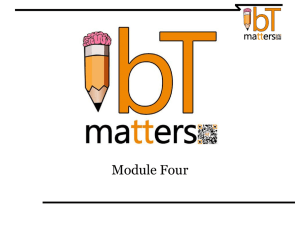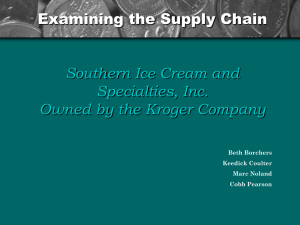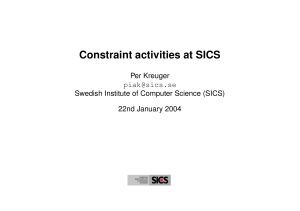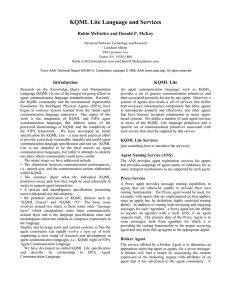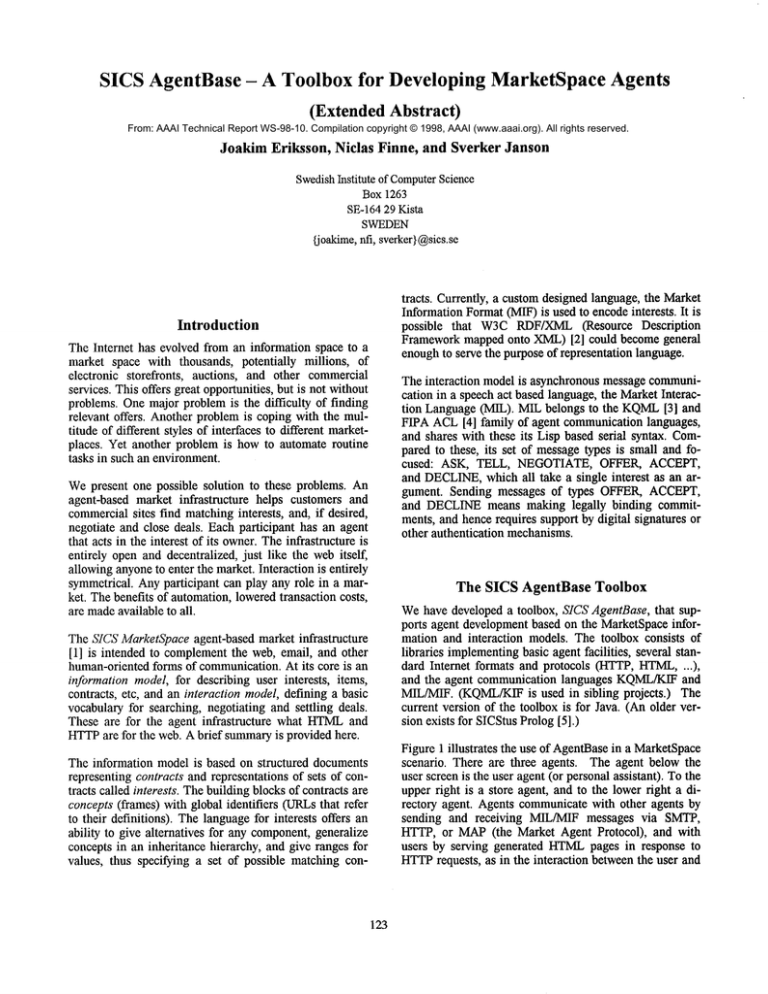
SICS AgentBase- A Toolbox for Developing MarketSpace Agents
(Extended Abstract)
From: AAAI Technical Report WS-98-10. Compilation copyright © 1998, AAAI (www.aaai.org). All rights reserved.
JoakimEriksson, Niclas Finne, and Sverker Janson
SwedishInstitute of ComputerScience
Box 1263
SE-16429 Kista
SWEDEN
{j oakime,nil, sverker}@sies.se
Introduction
The Internet has evolved from an information space to a
market space with thousands, potentially millions, of
electronic storefronts, auctions, and other commercial
services. This offers great opportunities, but is not without
problems. One major problem is the difficulty of finding
relevant offers. Another problem is coping with the multitude of different styles of interfaces to different marketplaces. Yet another problem is how to automate routine
tasks in such an environment.
Wepresent one possible solution to these problems. An
agent-based market infrastructure helps customers and
commercialsites find matchinginterests, and, if desired,
negotiate and close deals. Each participant has an agent
that acts in the interest of its owner.The infrastructure is
entirely open and decentralized, just like the webitself,
allowing anyoneto enter the market. Interaction is entirely
symmetrical. Anyparticipant can play any role in a market. The benefits of automation, loweredtransaction costs,
are madeavailable to all.
The SICS MarketSpaceagent-based market infrastructure
[1] is intended to complementthe web, email, and other
human-oriented forms of communication.At its core is an
information model, for describing user interests, items,
contracts, etc, and an interaction model, defining a basic
vocabulary for searching, negotiating and settling deals.
These are for the agent infrastructure
what HTML
and
HTTPare for the web. A brief summaryis provided here.
The information model is based on structured documents
representing contracts and representations of sets of contracts called interests. The building blocks of contracts are
concepts (frames) with global identifiers (URLsthat refer
to their definitions). The language for interests offers an
ability to give alternatives for any component,generalize
concepts in an inheritance hierarchy, and give ranges for
values, thus specifying a set of possible matching con-
123
tracts. Currently, a customdesigned language, the Market
Information Format(MIF)is used to encodeinterests. It
possible that W3CRDF/XML(Resource Description
Framework mapped onto XML)[2] could become general
enoughto serve the purpose of representation language.
The interaction model is asynchronous message communication in a speech act based language, the MarketInteraction Language (MIL). MIL belongs to the KQML
[31 and
FIPA ACL[4] family of agent communication languages,
and shares with these its Lisp based serial syntax. Compared to these, its set of messagetypes is small and focused: ASK, TELL, NEGOTIATE, OFFER, ACCEPT,
and DECLINE,
which all take a single interest as an argument. Sending messages of types OFFER, ACCEPT,
and DECLINEmeans making legally binding commitments, and hence requires support by digital signatures or
other authentication mechanisms.
The SICS AgentBase Toolbox
Wehave developed a toolbox, SICS AgentBase, that supports agent development based on the MarketSpaceinformation and interaction models. The toolbox consists of
libraries implementingbasic agent facilities, several standard Internet formats and protocols (HTTP,HTML
.... ),
and the agent communication languages KQML/KIF
and
MIL/MIF.(KQML/KIF
is used in sibling projects.) The
current version of the toolbox is for Java. (An older version exists for SICStusProlog [5].)
Figure 1 illustrates the use of AgentBasein a MarketSpace
scenario. There are three agents. The agent below the
user screen is the user agent (or personal assistant). To the
upper right is a store agent, and to the lower right a directory agent. Agents communicatewith other agents by
sending and receiving MIL/MIF messages via SMTP,
HTTP, or MAP(the Market Agent Protocol), and with
users by serving generated HTML
pages in response to
HTTPrequests, as in the interaction between the user and
UserScreen
Store
Ac#ve
HandlersAgent:Manager
WWW
Site
Product
Catalog
.~L
I
AcUve
AgentManager
Handlers
Interest
Knowledg~
&
Directory
~
\
\
Ontology
Manager
Handler
Manager
H’R’P
MAP
SMTP
Figure1: AMarketSpace
scenarioillustrating the use of AgentBase
in a user agent, in an
agentsupportedstore, andin a directoryservice.
the store. (See [6] for moreinformationabout interaction
betweenagents and users in MarketSpace.)
References
All agent addresses are URLs,in the case of MAP
addresses of the form map://domain:port/name.AgentBase
provides no agent nameserver. In MarketSpace,agents
publish their addressesas a part of advertisedinterests,
using the standardmessagetypes.
Figure1 illustrates the use of a directory agent for this
purpose.Agentspublishtheir interests in the directoryand
query it to find other agents with matchinginterests.
Agentsalso needto knowhowthey are expectedto interact aboutthe interest (i.e., by haggling,auctioning,etc.).
This informationis publishedas a part of the pertaining
interest togetherwith the address.Here, the auc7interaction type is to be used. Theagentsuse this informationto
start sub-agentsthat handlethat particular interaction.
SICSAgentBaseis used in four projects at SICS: an
agent-based market service (with Telia Research),
agent-based workflowmanagementsystem (with Telia
Research),the SICSDigital Libraryproject, and a conferencecall system.
124
1. JoakimEriksson,Niclas Finne, and SverkerJanson.
Informationand interaction in MarketSpace.
1996.
In 2nd USENIX
Workshopon Electronic Commerce. USENIX
Press.
2. W3CResourceDescription Framework.See
http:/lwww.w3.org/Metadata/RDF/.
3. YannisLabrouand TimFinin. Aproposal for a new
KQML
specification. 1997. Technical Report CS-9703, CSEEDept, UMBC.
4. FIPAACL,see URL:http://drogo.cselt.stet.it/fipa/
5. AnInternet softwareplatformbasedon SICStus
Prolog. 1997. WWW6
Workshop,see URL:
http://www.sics.se/~joakime/papers/platformwww/platform-www.html.
6. JoakimEriksson, Niclas Finne, and Sverker Janson.
To each and everyone an agent: augmentingwebbased commercewith agents. 1998. In Proceedings
of the International Workshop
on Intelligent Agents
on the Internet and Web,Fourth WorldCongresson
Expert Systems. See URL:http://www.sics.se/
~sverker/public/papers/agentweb.pdf

